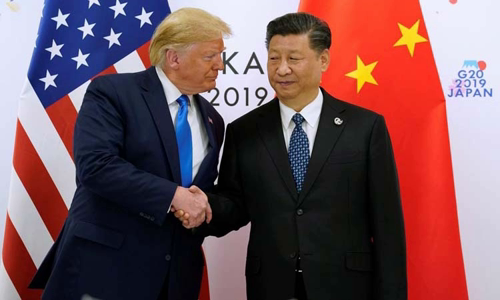The US-China trade war is like two rivals struggling fiercely on the ice, until one side falls into the pit.
Nearly 18 months since the trade war broke out, major differences between the US and China have persisted, although negotiations have been accelerated towards a first phase deal.

US President Donald Trump (left) shakes hands with Chinese President Xi Jinping at the G20 summit in Osaka, Japan on June 29. Photo: Reuters
The two sides agreed on a number of issues on intellectual property, financial services, currency and agriculture. US President Donald Trump also expressed hope that this agreement will help to end the trade war soon. However, the White House boss insisted that he only accepted the deal that made him "satisfied" and at the same time threatened to raise Chinese taxes "even higher" if the two sides did not reach a consensus.
Trump's threat was seen as a "cold water ladle" on China, when the state-run Xinhua news agency earlier reported officials had a "constructive" phone conversation on November 16. about the first phase deal.
"The current mood in Beijing about the trade deal is very pessimistic," NBC correspondent Eunice Yoon wrote on Twitter, citing Chinese government sources. "China is worried when Trump announced that he would not retract his taxes, which they once thought was agreed in principle. Their strategy now is to continue negotiations but still wait for the results of the investigation. Trump crimes and US presidential elections ".
Forbes commentator Kenneth Rapoza said that this situation is creating a tension between the US and China in the trade war, when both sides are determined to wait for the opponent to stumble.
For China, the prolonged trade war has a strong impact on the country's economy, when GDP in the third quarter only reached a growth rate of 6% over the same period last year, the lowest in more than 27 years. Many other economic indicators are also disappointing. According to research by US bank Morgan Stanley, the growth of China next year can be reduced to 5.3% if trade tensions escalate.
Beijing has reduced personal income taxes and subsidies for consumers to stimulate purchasing power. However, retail sales growth in the first 10 months of this year was only 8.1%, while last year's index was 9.2%. "Households prioritize saving over spending in the context of trade tensions and uncertain job markets," Morgan Stanley explained.
Although still the world's most important "factory", China is gradually losing market share as Southeast Asian countries rise to become an alternative low-cost source of supply. Some African countries like Egypt, Kenya and Madagascar also boosted the production of bulk goods.
However, Chinese President Xi Jinping has an advantage that Trump does not have: that he is not limited in term of office. This allowed him to adopt a "time-grabbing" tactic, in the context that companies withdrew from China were not as alarming as initially predicted.
"China still seems to have the intention of trying to wait for Trump to leave office instead of clinging to hope for the first phase deal, which was skeptical in the first place," said Michael Every, head of market research at Dutch bank Rabobank, reviews.
Some argue that Beijing's approach means there will be no trade agreement with Washington. With its "time-consuming" tactics, China is likely to find every way to pull and compete with the US, despite Trump's threats.
According to commentator Rapoza, if Trump gets angry at the fact that China is ignoring him, or even thinks it is politically against him, Beijing is likely to be subject to higher taxes. This risk will at least take place on 12/15, the deadline for Washington's next tax blow is expected to take effect.
If Trump implements the threat of a sharp increase in tariffs on China, the trade war between the two countries will escalate further, making the "liver competition" even more fierce.
However, Trump is also under pressure as the race to the White House in 2020 is imminent. The US president is expected to find a way to bring China back to the negotiating table and try to reach an agreement to appease the Republican party as well as the business community, strengthening the support of voters.
Commentator Rapoza explained that Trump could hardly give up the phase one deal when Wall Street was deadlocked and American farmers, who helped Democrats regain the lower house in the midterm elections in November 2018. , earnestly seeking help because the Trump administration grant does not seem to be enough.
Along with the impeachment investigation by Democrats, the impasse in the trade war could provide additional "weapons" for Trump's opponents. However, so far Trump's "both punching and rubbing" tactic has not caused China to give up anything. Meanwhile, Beijing maintains a "time-playing style", continues pursuing the goal of high quality growth and accelerating market opening.
"The two sides will only cooperate when they can't fight anymore. If you want to accelerate the transition from meaningless conflict to cooperation, you need to solve your internal problems well. Americans are less patient. and in a hurry, while China is always famously calm, "said Zhang Yansheng, an expert at China International Economic Exchange Center.



 ShaunaPGreen
ShaunaPGreen







